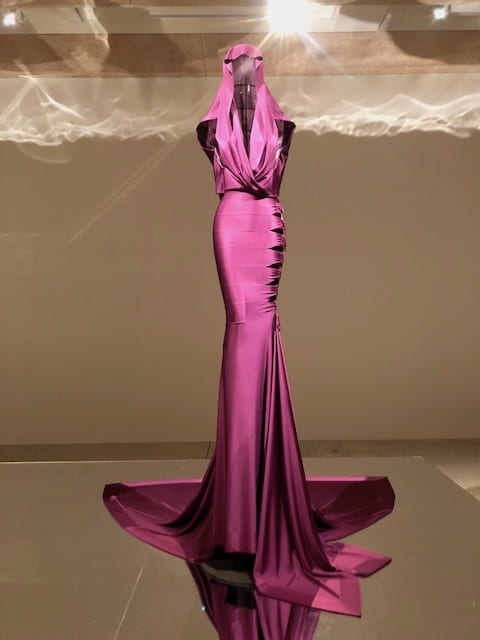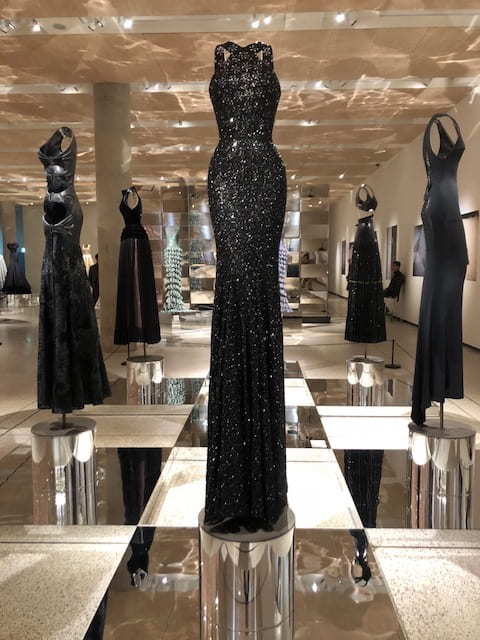Azzedine Alaïa: The Couturier Exhibition

“I always feel free. When I don’t want something, I don’t make it”
Tunisian-born couturier Azzedine Alaïa was always seen as an outsider in the world of fashion. He always dressed in a uniform of back and always worked to his own schedule. Azzedine ignored the traditional fashion collection calendar and continuously created work that generated excitement and respect.
Sensuous, body-hugging forms, described as ‘second skin’ dressing were Alaïa’s enduring influence. He experimented with the latest stretch materials and precisely tailored leather, creating curves and structure, he knew a woman’s body better than herself.
Alaïa thought with his hands. He gave his ideas form by shaping, draping cutting and pinning fabric directly onto statuesque models. He combined his rigorous technical skills with an understanding of how women wanted to feel. With many of his elegant creations worn by celebrities from Grace Jones, Lady Gaga, Greta Garbo to Naomi Campbell, Scarlett Johanasson and Rihanna.

“I make clothes, women make fashion”
Reflecting a consistency of approach and the timelessness of his creations, Alaïa’s most significant works are grouped below to reveal ideas he perfected and re-mastered over many years. This includes Alaïa’s famous use of black, his favourite and most widely used colour. Restricting his colour palette left Alaïa nowhere to hide and enabled him to develop the purist expressions of his ideals of form. As Alaïa explorations in shape and volume deepened, he remained focused solely on the demands of perfecting his vision, not on market demands.

Haute Couture & Ready To Wear
“I don’t see the difference between Haute Couture and ready-to-wear, everyone should do what feels good to express creativity”
Haute couture garments are entirely made to order, mostly by hand and fitted to each individual customer whereas ready-to-wear are those manufactured in standardized sizes and offered for sales in store across the world. Azzedine Alaïa began his career in haute couture – briefly at Christian Dior then at Guy Laroche – after which he created his own fashion house, creating made-to-order clothes for clients. These garments are the most technically complex and demanding, fusing cutting edge technology with techniques that date back to the 19thcentury. He then took these techniques and adapted them to the world of ready to wear. He hand cut the patterns for every garment himself and fitted the originals with his own hands and this is why his clothes demonstrate a superlative technique, blurring the lines between these two other wise distinct worlds.

Sculptural Tension
“Art came first, for me”
Azzedine originally trained as a sculptor in Tunis, and he always considered his clothing in sculptural terms. Uniquely in the world of fashion, he used his own hands to give his creation form, shaping and moulding fabric as others would use marble or clay. In turn, Alaïa’s garments sculpted and reshaped the female body, consistently deploying unexpected materials to achieve their goals. Metal is used here to transform the textile into magical and mercurial. A theme from his final Haute Couture show in 2017. Metal is used to blur the boundaries between strength and lightness, challenging himself, his craftspeople and the materiality of the world around him.

Decoration and Structure
“Material can trigger a form”
A trademark of Azzedine’ work was to avoid surface embellishment such as embroidery or applied decoration – symbolic elements or haute couture over the past half century. Instead Alaïa keyed pattern into the very fabric of his garments, making it an internal part of the structure.

Revolutionary Skills
“Leather is a material I sometimes wanted to make more feminine, more delicate, more fragile. I treated it in the same way as other haute couture fabrics”
Alaïa’s use of leather was revolutionary. He translated it from a fabric of rebellion, of sexual and societal transgression, into one of utmost elegance. Alaïa gained international attention from a leather coat he constructed in 1981. Studded with eyelets, the coat foreshadowed the hard-edge style that defined the coming decade.

Exploring Volume
“Making the right volume is a technique that is just as complex as any other. It demands good mathematics”
He pushed this idea to the extreme with these voluminous ballgowns. They represent his life-long fascination with fashion history and respect for the past. The dresses re-examine the grandeur of costume in the 17th&18thcenturies, re-imagining the shapes and effects through contemporary technologies and attitudes towards the body. Echoing work of Balenciaga, he rarely used internal structures such as boning and petticoats, instead used the fabrics themselves to create the structure.

Spanish Accent
“The first fashion I remember was Velazquez – Las Meninas”
Alaïa’s work is marked by fervent curiosity about other places, cultures and customs. The influence of Spain, just across the Mediterranean from his native north African home emerges throughout his collections. Alaïa was inspired by the vibrancy of Spanish folk costume. Alaïa’s flamenco-inspired ruffles give the dresses energy and movement.

Black Silhouettes
“I like black, for me, it’s a happy colour”
Alaïa’s sense of colour was highly refined, yet often overlooked. Others often reduced his output to the little black dress, of which he was the master. He often used soft greys, camels and browns. However, black was his favourite colour. He would use it, on its own, combining multiple fabrics in a single garment to explore different textual qualities. He liked that the anonymity of black focused the attention on the women wearing his creations, not the clothes. It allowed dresses to be reduced to an idealised perfectly created form.

Wrapped Form
“I had used stretch materials for years to shape the inside of garments I made for private clients. Then I just started using them in my own”
Azzedine’s innovations transformed the silhouettes of the wearer. Rather than creating clothes anchored at strategic points- conventionally the waist and shoulders. His bandage dresses cling to the wearers form, conscious of the entire body. The stretch allows the body to move freely. The dresses seem simple, but each band of fabric is precisely engineered and cut to specific dimensions, according to its place on the figure. These creations ushered in the notion of bodycon dresses in the 90’s.

Alaïa obeyed no rules but his own, and this made him truly a unique and magnificent designer.
To find out more information and view Azzedine Alaïa collections, please visit:




